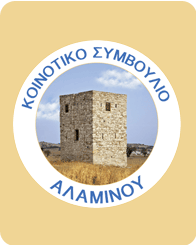The community of Alaminos is found at about
28 kilometres from the city of Larnaca, between the villages
Agios Theodoros, Kofinou, Anafotia, and Mazotos.
It has an average altitude of 75 meters and
receives an average annual rainfall of about 400 millimetres.
Chiefly fruits and vegetables (tomatoes, cucumbers, and artichokes) are cultivated in the village's tracts.
The village went through a steady increase
of population until 1960. In 1881 its inhabitants numbered 243,
increasing to 313 in 1911, to 340 in 1931, and to 564 in 1960.
The community's Turkish-Cypriot inhabitants numbered 251 in
1960. After the 1974 Turkish invasion, the community's Turkish-Cypriot
inhabitants abandoned the village and settled in the occupied
part of the island; several refugees from the occupied territories
settled in the village. Today the inhabitants run into 300 -among them 40 refugees.
In recent years neither decrease of the population nor the urban
pull phenomenon were observed due to the granting of large tracts
of land to new families for settling in the community.
 |
| The Village |
N. G. Kyriazis reports that "genuine Turks" inhabited
Alaminos, thus the village was a mediaeval feud that the Turks
misappropriated after the conquest of Cyprus in 1570-1571, a
thing that happened to many other villages of Cyprus.
 |
| Traditional House |
The village appears marked as Alamino in old maps. Its name
was considered of French origins and was -erroneously -related
by several researchers to the monastery of St. George "Alamanos",
where "Alamanos" is of mediaeval origins. The confusion
was due to the fact that -during the Frank domination -the Alaminos
village was prince John's, brother of King Peter I, feud since
1367. Other erroneous, older publications present the village
as property of Philip d' Impellen. D' Impellen's relevance to
the village was that he was imprisoned there on the 8/4/1308.
Contrary, the correct information is that in 1463 the village
was granted to nobleman John Lorendano.
 |
| Traditional House |
According to a more simplified version, the daughter of a
nobleman who was named Minio disappeared from the village and
all the inhabitants were looking for her, calling out "ela
Minio, ela Minio" (ela = come) and so the village took
the name Alaminos.
Crossing the community you will travel through narrow,
picturesque alleys, which provide a different dimension
to the landscape through the imposing presence of the old, traditional
houses that are ridden in green and flowers. Most houses, almost
untouched and without any alteration, witness the rich history
of the place.
 |
| Traditional House |
Continuing our journey through the community we will pass
by the old church of "Agios Mamas",
which is another ancient monument of the village. Leaving the
church and going uphill, crossing the bridge to the community's
Turkish-Cypriot side, the houses and the alleys unwind a different
era and history.
Coming out of the village we will face the glorious and magisterial "Koulas", standing silent and stately. "Koulas" is considered as a 15th century
structure and is an oblong, parallelepiped, stone-made castle.
It was used by the village's inhabitants, during the old times,
so as to observe their enemies coming from the sea and confront
them. It was a significant structure for the village's inhabitants,
since there were underground tunnels and paths that led from
the village to the sea.
 |
| Koulas |
Today the community develops its tourism through the creation of a large hotel complex.
|
